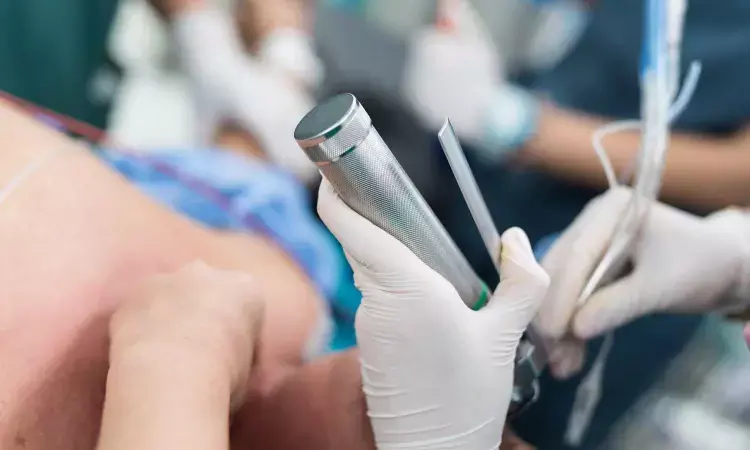- Home
- Medical news & Guidelines
- Anesthesiology
- Cardiology and CTVS
- Critical Care
- Dentistry
- Dermatology
- Diabetes and Endocrinology
- ENT
- Gastroenterology
- Medicine
- Nephrology
- Neurology
- Obstretics-Gynaecology
- Oncology
- Ophthalmology
- Orthopaedics
- Pediatrics-Neonatology
- Psychiatry
- Pulmonology
- Radiology
- Surgery
- Urology
- Laboratory Medicine
- Diet
- Nursing
- Paramedical
- Physiotherapy
- Health news
- Fact Check
- Bone Health Fact Check
- Brain Health Fact Check
- Cancer Related Fact Check
- Child Care Fact Check
- Dental and oral health fact check
- Diabetes and metabolic health fact check
- Diet and Nutrition Fact Check
- Eye and ENT Care Fact Check
- Fitness fact check
- Gut health fact check
- Heart health fact check
- Kidney health fact check
- Medical education fact check
- Men's health fact check
- Respiratory fact check
- Skin and hair care fact check
- Vaccine and Immunization fact check
- Women's health fact check
- AYUSH
- State News
- Andaman and Nicobar Islands
- Andhra Pradesh
- Arunachal Pradesh
- Assam
- Bihar
- Chandigarh
- Chattisgarh
- Dadra and Nagar Haveli
- Daman and Diu
- Delhi
- Goa
- Gujarat
- Haryana
- Himachal Pradesh
- Jammu & Kashmir
- Jharkhand
- Karnataka
- Kerala
- Ladakh
- Lakshadweep
- Madhya Pradesh
- Maharashtra
- Manipur
- Meghalaya
- Mizoram
- Nagaland
- Odisha
- Puducherry
- Punjab
- Rajasthan
- Sikkim
- Tamil Nadu
- Telangana
- Tripura
- Uttar Pradesh
- Uttrakhand
- West Bengal
- Medical Education
- Industry
C-MAC D-blade video laryngoscope tied to faster nasotracheal intubation during traumatic cervical spine surgery

Patients with cervical spine instability have difficulty managing their airways because neck manipulations carry a risk of neurological impairment. It has been shown that the McCoy laryngoscope, with its distinctive design, offers superior glottic vision compared to the traditional Macintosh blade. In comparison to the McCoy laryngoscope, a recently published research assessed the effectiveness of the C-MAC-D blade in facilitating quicker tracheal intubation and improving glottic visibility in patients with cervical spine injuries.
The study included fifty individuals, aged 18 to 60, undergoing cervical spine surgery. People with a body mass index more than 24.9 kg/m2 and those with an impaired airway were not admitted. The whole population was randomly split into two groups using a random number table produced by the computer. The study used a McCoy laryngoscope for Nasal Intubation (NTI) in Group M and a C-MAC video laryngoscope for Group C. After preparing oxymetazoline hydrochloride, the nasal passage was lubricated with 2% xylocaine jelly. The NTI period was divided into three phases, with Magill forceps being utilised as required. Intubation failure was defined as a drop in SpO2 below 92% and an inability to intubate after 120 seconds or three efforts. Furthermore, measurements were taken of the heart rate, mean arterial pressure, and SpO2 just before to intubation as well as one and three minutes afterwards.
50 of the 79 individuals that underwent screening were selected to take part in the study. Group C had a much shorter intubation duration than Group M. Both groups required almost the same amount of time for the first stage of the intubation, roughly the same amount of time for the second step, and much less time for Group C for the third stage. Magill forceps were used on all patients in Group M, however they were required on just three patients in Group C. At one and three minutes after NTI, both groups' MAP and HR significantly increased in comparison to their pre-NTI values (P < 0.001). Regarding MAP (P = 0.257) and HR (P = 0.632), there were no intergroup differences.
In the current research, intubation times were shorter for the group using a C-MAC D-blade video laryngoscope than for the group using a McCoy laryngoscope. The D-blade's pronounced curvature considerably reduced the oropharyngeal–laryngeal axis's necessary alignment. Additionally, this blade lessened the need for any extra force to be used during laryngoscopy. It takes longer to secure the airway with alternative laryngoscopes because more supportive motions are needed.
Reference –
Singh, Swati1; Kumar, Amit1; Kumar, Brajesh2; Singh, Swarnika1. Comparison between C-MAC D-blade video laryngoscope and McCoy laryngoscope for nasotracheal intubation in traumatic cervical spine surgery – A randomised controlled trial. Indian Journal of Anaesthesia 67(9):p 821-824, September 2023. | DOI: 10.4103/ija.ija_347_23
MBBS, MD (Anaesthesiology), FNB (Cardiac Anaesthesiology)
Dr Monish Raut is a practicing Cardiac Anesthesiologist. He completed his MBBS at Government Medical College, Nagpur, and pursued his MD in Anesthesiology at BJ Medical College, Pune. Further specializing in Cardiac Anesthesiology, Dr Raut earned his FNB in Cardiac Anesthesiology from Sir Ganga Ram Hospital, Delhi.
Dr Kamal Kant Kohli-MBBS, DTCD- a chest specialist with more than 30 years of practice and a flair for writing clinical articles, Dr Kamal Kant Kohli joined Medical Dialogues as a Chief Editor of Medical News. Besides writing articles, as an editor, he proofreads and verifies all the medical content published on Medical Dialogues including those coming from journals, studies,medical conferences,guidelines etc. Email: drkohli@medicaldialogues.in. Contact no. 011-43720751


